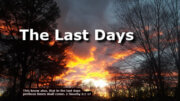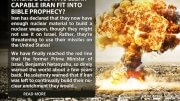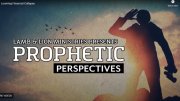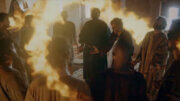Editor’s note: see our other posts on Thanksgiving https://vachristian.org/tag/thanksgiving/
Stephen McDowell | Providence Foundation
One great factor in the secularization and decline of America is the teaching of revisionist history in our schools. As an example of this, a friend recently wrote me that two American Indian history teachers at Minnesota State University told him that Thanksgiving was the celebration of the massacred 600 Pequot Indians in colonial New England.
Wanting to learn more of why they thought this, my friend found an article that seemed to detail their beliefs, in which is stated:
Ironically, the first official “Day of Thanksgiving” was proclaimed in 1637 by Massachusetts Governor John Winthrop. He did so to celebrate the safe return of English colony men from Mystic, Connecticut. They massacred 600 Pequots that had laid down their weapons and accepted Christianity. They were rewarded with a vicious and cowardly slaughter by their new “brothers in Christ.”[1]
Unfortunately, too many Americans today would readily believe this almost totally false statement.
Having read much about these early settlers, and knowing the lies and half-truths that are presented as history today, I was able to point out why this statement is wrong.
First, the context of the Pequot Indian war was not as they represent. The Pequots had not laid down their weapons nor accepted Christianity. In reality, they were terrorists who had kidnapped and killed many men, women, and children over the prior years.
 Pequot Indian War
Pequot Indian War
The Pequot Indian war was the first European-Indian war in New England. On one side was the greatly feared Pequot tribe, on the other the colonists and the Narragansett, Mohican, and Mohawk Indians. The Pequots (or Pequods) were a hostile tribe who had fought and lorded over other Indian tribes long before Europeans settled in the area. Their hostility was especially shown to the white settlers who first arrived in late 1620. With the influx and inland settlement of new colonists, hostile encounters increased.
In 1633 Pequot warriors murdered the captain and crew (8 men total) of a small Massachusetts vessel trading in the Connecticut River area. After this they massacred some Indians friendly to the Dutch, who had a garrison in the area. The Dutch retaliated by capturing and hanging a few Pequots, who then took up arms against the Dutch. They sought the friendship of the English, and for that purpose sent four or five ambassadors to Boston in November 1634 to negotiate a treaty. In return for their help, which included negotiating peace with their long-time enemy the Narragansett Indians, the Pequots gave them some land in the Connecticut valley and promised to surrender the remaining two murderers of Captain Stone’s party. The leaders of Massachusetts accepted their claim conditionally and then helped reconcile the Pequots and the Narragansetts.
The Pequots, however, never gave up the murderers, nor did they keep the peace with the Englishmen. In fact, they kidnapped children, destroyed or made captive families on the borders of the settlements, and murdered Englishmen they found alone in the woods or on the waters.[2]
In July, 1636, another trader, John Oldham, was murdered and his men carried off by the Pequot Indians on Block Island. At this, “God stirred up the hearts” of Governor Vane and the rest of the magistrates to protect their people.[3] To punish the crime, Massachusetts sent 90 men under the command of John Endicott. This force encountered some Pequots at Block Island and in a brief battle they killed a few Indians and destroyed their wigwams and much property. The Indians fled and Endicott followed them to the mainland. Upon encountering the Pequots, he demanded they surrender the murderers. When they did not, Endicott attacked them, killing a score of them and destroying some of their corn. Such a reprisal only enraged the Pequots, who in subsequent conflicts captured and scalped seven of the Massachusetts men.[4]
 Re-enforcements came from Connecticut to assist them in their mission to totally defeat the Pequots and stop the attacks and murders. Showing no signs of remorse, the Pequots sought the alliance of the neighboring Narragansetts and Mohicans (or Mohegans), and continued to murder those whites they came upon. With requests from Massachusetts, Roger Williams traveled alone to the sachem of the Narragansetts to convince him not to align with the Pequots. When Williams arrived, the Pequot ambassadors, “reeking with blood freshly spilled,”[5] were already there. For three days Williams lodged and mixed with them, always fearing for his life. In the end he succeeded in keeping the Narragansetts from joining with the Pequots, who remained alone in the war with the English.
Re-enforcements came from Connecticut to assist them in their mission to totally defeat the Pequots and stop the attacks and murders. Showing no signs of remorse, the Pequots sought the alliance of the neighboring Narragansetts and Mohicans (or Mohegans), and continued to murder those whites they came upon. With requests from Massachusetts, Roger Williams traveled alone to the sachem of the Narragansetts to convince him not to align with the Pequots. When Williams arrived, the Pequot ambassadors, “reeking with blood freshly spilled,”[5] were already there. For three days Williams lodged and mixed with them, always fearing for his life. In the end he succeeded in keeping the Narragansetts from joining with the Pequots, who remained alone in the war with the English.
Continued attacks and murders roused Connecticut to action. “All through the winter of 1636-37 the Connecticut towns were kept in a state of alarm by the savages. Men going to their work were killed and horribly mangled. A Wethersfield man was kidnapped and roasted alive. Emboldened by the success of this feat, the Pequots attacked Wethersfield, massacred ten people, and carried away two girls.”[6] To help bring spiritual aid, Boston had declared a Fast Day on January 19, 1637, recognizing the “dangers of those at Connecticut.”[7]
Cotton Mather records this event during this frightening time:
A Pequot-Indian, in a canoo, was espied by the English, within gunshot, carrying away an English maid, with a design to destroy her or abuse her. The soldiers fearing to kill the maid if they shot at the Indian, asked Mr. [Rev. John] Wilson’s counsel, who forbad them to fear, and assured them “God will direct the bullet!” They shot accordingly; and killed the Indian, though then moving swiftly upon the water, and saved the maid free from all harm whatever.[8]
In response to the Pequot atrocities, the leaders of the three infant towns meeting at a General Court (legislature) in Hartford, decreed war on May 1, 1637. They sent 60 to 90 men, one third of the whole colony, under the command of Captain John Mason, and accompanied by Rev. Samuel Stone as chaplain, to attempt to stop the Pequots from their murderous attacks. They were joined by Captain John Underhill and 20 or so men from Massachusetts. Before departing they likely observed a Day of Prayer and heard a sermon from Rev. Thomas Hooker.[9]
Before engaging the Pequots, they first sought help from friendly Indian tribes. The Mohicans, led by their chief Uncas, allied with them, sending 70 men to fight. They met with the Narragansetts, led by Canonicus and Miantonomoh. These chiefs supported them in the efforts against their common enemy but thought the whites were too weak to defeat the mighty Pequots, who had 2000 to 3000 warriors,[10] but nonetheless sent about 400 of their men to join them in battle. The colonists were glad for this support but had some concern of the fidelity of their Indian allies. Captain Underhill said one day he found Chaplain Stone praying with the soldiers, with these words:
“O Lord God, if it be thy blessed will, vouchsafe so much favor to thy poor distressed servants, as the manifest one pledge of thy love that may confirm us of the fidelity of these Indians toward us, that now pretend friendship and service to us, that our hearts may be encouraged the more in this work of thine.”[11]
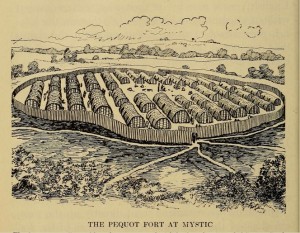 Not long after this prayer, they heard that five Pequots were slain by the Mohicans. One historian records how “the news was welcome to them, and looked upon as a special providence.”[12]
Not long after this prayer, they heard that five Pequots were slain by the Mohicans. One historian records how “the news was welcome to them, and looked upon as a special providence.”[12]
As they marched through the wilderness seeking the Pequot fort, they asked for the chaplain’s advice in military strategy, which before giving he spent a night in prayer seeking wisdom from God. The captain acknowledged God’s leadership in directing them on their way. The day before the fight, a fast day was observed in Massachusetts.[13] On the eve of the battle, the chaplain earnestly prayed for the hungry and tired men. On the morning of the attack he “yielded themselves up to God and entreated his assistance.”[14]They needed His assistance for they were greatly outnumbered.
As they approached the stronghold of the Pequots, the allied Indians, who greatly feared the Pequot leader Sassacus, slunk back. So on May 26, 1637, only 77 Englishmen attacked the fort that the Pequots had built on the summit of a hill. “The colonists were fighting for the security of their homes; if defeated, the war-whoop would resound near their cottages, and their wives and children be abandoned to the scalping-knife and the tomahawk.”[15] While the English had superior weapons, the Pequots greatly outnumbered them, so during the initial stages of the battle the English decided to burn them out, casting firebrands on the cabins and fort. Everything quickly became inflamed and in the chaos, the English were able to take down the Pequots. About 600 Indians, mostly men but also some women and children, perished in the flames and in the battle.[16] The Pequots who escaped the fighting were caught and killed by the Indian allies who had remained at a distance. Only five got away.
Other Pequot warriors in the surrounding area carried on the fighting after this, but eventually were defeated and surrendered. The Mohawk allies of the whites killed the Pequot sachem, Sassacus. Some of those that surrendered were enslaved and incorporated among the Mohicans and the Narragansetts.
This victory by the English in the first Indian war in New England struck terror into the Indians and secured a long period of peace and security for the settlers in the area. The Pequot Indians had terrorized the area for a long time, both before the English settled there and afterwards. The Mohicans and Narragansetts were as glad as the English of their utter defeat. To some it might seem the English treated the Pequots harshly, but the English were responding to terrorists who considered it normal to torture and slay others. They were fighting for their very existence with a people who knew nothing of civilized warfare, where only the designated army would fight.
Nineteenth century historian John Fiske writes:
As a matter of practical policy the annihilation of the Pequots can be condemned only by those who read history so incorrectly as to suppose that savages, whose business is to torture and slay, can always be dealt with according to the methods in use between civilized peoples. A mighty nation, like the United States, is in honour bound to treat the red man with scrupulous justice and refrain from cruelty in punishing his delinquencies. But if the founders of Connecticut, in confronting a danger which threatened their very existence, struck with savage fierceness, we cannot blame them.[17]
The Pequots were somewhat like the modern ISIS Muslim terrorists, who have indiscriminately murdered innocent men, women, and children and have no interest in living peacefully with those they consider their enemies.
In response to their victory the towns of Connecticut most surely proclaimed days of thanksgiving; however, no record survives of these. Massachusetts observed the 15th of June as a Day of Thanksgiving. Churches in various towns would have observed thanksgiving days as well. It was in the fall that a general day of thanksgiving was kept throughout New England. In his History of Connecticut, Trumbull says: “This happy event gave joy to the colonies. A day of public thanksgiving was appointed, and in all the churches of New England devout and animated praises were addressed to Him who giveth his people the victory.”[18] The Massachusetts Colonial Records show they observed this day on October 12th and lists some reasons for the Thanksgiving Day including: “for His [God’s] great mercies in subdewing the Pecoits, bringing the soldiers in safety, the successe of the conference, & good news from Germany.”[19]
The conference mentioned was a meeting of church leaders in Cambridge, Massachusetts, in August at which a “plan for union” was proposed. To help facilitate this union, these leaders likely proposed that all the colonies observe a united Day of Thanksgiving. Therefore, the first general Thanksgiving Day in New England was observed on October 12, 1637. But this was not the first official day of Thanksgiving, nor the day we look to as the origin of our Thanksgiving Holiday. (See the article “Why We Celebrate Thanksgiving”to learn this history.)
Many thanksgiving days were proclaimed before this and many more would be proclaimed afterwards. In fact, there were at least 1400 Fast or Thanksgiving Days proclaimed by civil government leaders, first on the state and then later the national level, from 1620 until around 1815.[20]
In light of the above history, it is clear that the statement presented at the beginning of this article about “the first official ‘Day of Thanksgiving’” contains great distortions and lies. To reiterate a few false points in that paragraph:
This was not the first official Day of Thanksgiving, as the Plymouth and Massachusetts Colonies had observed such days in prior years. Plymouth had proclaimed Thanksgiving Days for Dec. 20, 1620, in Oct. 1621, on July 30, 1623, in June, 1633, and possibly others as well. They also proclaimed numerous Days of Fasting. Gov. Winthrop of Massachusetts had proclaimed Thanksgiving Days on July 8, 1630, Feb. 22, 1631, June 13, 1632, and June 19, 1633. Various towns in Massachusetts proclaimed Thanksgiving Days as well. In addition, there were numerous Fast Days proclaimed during these first years.[21]
The Thanksgiving Day observed on October 12, 1637, may have been the first such day observed by all the New England colonies together.[22] The October 12th proclamation mentions God’s “great mercies in subdewing the Pecoits,” and Governor Winthrop, no doubt, acknowledged the victory in his June 15thproclamation, but the Pequots had not laid down their weapons nor accepted Christianity. The colonists were fighting a war against an enemy with vastly superior forces. When the fort was attacked they did not know the number of warriors inside. They knew they were greatly outnumbered, and if they did not obtain complete victory they would have been slaughtered, but not just them. All their wives and children who were at their homes in the newly planted towns in Connecticut would have been killed or enslaved or worse. This was not a cowardly slaughter but was a just war against an enemy who had terrorized them for years.
The Christian colonists would have loved to see the Pequots converted to Christ. After all they had come to start a new colony in order to propagate the Gospel – to “win the Natives of the Country to… the Christian Faith,” as stated in the Charter of Massachusetts Bay.[23] Many Native Americans had been converted, and many more would be in the decades following, especially due to the efforts of Rev. John Elliot, who translated the Bible into the Algonquin language and set up 14 towns of Christian Indians. The Pequots in general were not interested in the Gospel, but rather in terrorizing the settlers.
In summary, the Pequot War was a just war against an intransigent enemy who had terrorized, killed, and captured whites and other Native Americans for many years. It showed a great courage of the early settlers, a remarkable military achievement against overwhelming odds, and a wonderful deliverance by a just God who fights for the oppressed and afflicted. After obtaining a victory it is no wonder they gave thanks to their God and Father.
Stephen McDowell, the President of the Providence Foundation in Charlottesville and also President of the Foundation’s Biblical Worldview University. He has written numerous books and training courses on America’s Christian history and on the need to live by Biblical principles in order to prosper as a nation.
[1] http://www.americanindiansource.com/mourningday.html
[2] Benson J. Lossing, Our Country, A Household History of the United States, New York: James A. Bailey, 1895, Vol. 1, p. 247.
[3] John Fiske, The Beginnings of New England, Boston: Houghton, Mifflin, and Co., 1898, p. 140.
[4] America, Great Crises in Our History Told by Its Makers, Vol. 2, Introduction to “The Pequot Massacre at Fort Mystic,” by Captain John Mason, Chicago: Veterans of Foreign Wars, 1925, p. 143.
[5] George Bancroft, History of the United States of America, Boston: Little, Brown, and Co., 1879, vol. 1, p. 313.
[6] John Fiske, The Beginnings of New England, p. 142.
[7] W. DeLoss Love, The Fast and Thanksgiving Days of New England, Boston: Houghton, Mifflin, and Company, 1895, p. 131.
[8] Cotton Mather, Magnalia Christi Americana [The Great Works of Christ in America] (first published in 1702), Hartford: Silas Andrus and Son, 1853, Vol. 1, p. 314, photo-litho reprint by The Banner of Truth Trust, Edinburgh, 1979.
[9] Love, p. 132.
[10] Lossing, p. 247, and America, p. 143.
[11] Love, pp. 132-133.
[12] Love, p. 133.
[13] Ibid.
[14] Love, p. 134.
[15] Bancroft, Vol. 1, p. 315.
[16] Captain Mason records how 150 men came from another Pequot fort the night before the battle as reinforcements. America, “The Pequot Massacre at Fort Mystic,” by Captain John Mason, p. 147.
[17] Fiske, p. 145.
[18] Quote in Love, p. 135.
[19] Love, p. 135.
[20] See Love, pp. 464-514, for a listing of these.
[21] See Love, pp. 464-465.
[22] Love, pp. 135-136.
[23] Sources of Our Liberties, Richard L. Perry, editor, New York: American Bar Foundation, 1952, p., 94.

